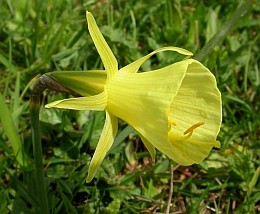Narcissi of the Picos de Europa
Teresa Farino
08/03/2009 15:52:20
Four species of Narcissus in a single morning in early March!
Posted in: Flora, Endangered Wildlife and Habitats | Asturias, Cantabria | Mainland Spain, Northern Spain
 Angel's-tears
Angel's-tears
Narcissus triandrus© Teresa FarinoSince the beginning of 2009 the thermometer on my terrace here in Pesaguero (Cantabria) has registered minima and maxima of –8ºC and 21ºC respectively. Yes, we’ve had more snow this winter than for many years, but equally, these periods of snowfall have been punctuated with a series of anticyclones, bringing warm, clear days.
Just recently, heavy snow on 4 and 5 March had given way once more to fine weather by yesterday (7 March), tempting me away from the computer. Typical spring flowers such as Celandine, Hepatica, Stinking and Green Hellebores, Cowslip, Primrose and Colt’s-foot have been in bloom since February, but a botanist’s life starts to get much more interesting come March. The delightful little Romulea bulbocodium (Iridaceae) is now in flower in dry meadows, while Large-flowered Butterwort (Pinguicula grandiflora), Leafless-stemmed Globularia (Globularia nudicaulis) and Giant Orchids (Barlia robertiana) are all in full bloom in the sheltered depths of the La Hermida gorge.
 Narcissus pseudonarcissus ssp. pallidiflorus© Teresa FarinoMore excitingly, yesterday I located no fewer than four different narcissi growing in and around the eastern edge of the Picos de Europa. One - Narcissus pseudonarcissus ssp. pallidiflorus (N. pallidiflorus) - was a completely new plant for me, although a glance at the Anthos website revealed that it is fact fairly widespread in the hinterland of the northern Spanish coast, and it has also been cited in the Catálogo florístico del Parque Nacional de los Picos de Europa, 2007, produced by the Jardín Botánico Atlántico in Gijón. That said, I also see that in the updated Lista Roja 2008 de la Flora Vascular Española it is considered to be Near Threatened in Spain. My specimens of this pale-flowered ‘wild daffodil’ were growing in damp hazel coppice near Panes (Asturias).
Narcissus pseudonarcissus ssp. pallidiflorus© Teresa FarinoMore excitingly, yesterday I located no fewer than four different narcissi growing in and around the eastern edge of the Picos de Europa. One - Narcissus pseudonarcissus ssp. pallidiflorus (N. pallidiflorus) - was a completely new plant for me, although a glance at the Anthos website revealed that it is fact fairly widespread in the hinterland of the northern Spanish coast, and it has also been cited in the Catálogo florístico del Parque Nacional de los Picos de Europa, 2007, produced by the Jardín Botánico Atlántico in Gijón. That said, I also see that in the updated Lista Roja 2008 de la Flora Vascular Española it is considered to be Near Threatened in Spain. My specimens of this pale-flowered ‘wild daffodil’ were growing in damp hazel coppice near Panes (Asturias).
 Narcissus asturiensis© Teresa FarinoThe cream-coloured, multi-flowered Angel’s-tears N. triandrus was also coming into bloom where more acid rock combines with humid conditions in sunny localities, while the diminutive N. asturiensis, which is listed on Annex II of the European Habitats Directive (92/43/EEC), was almost over in its La Hermida gorge locality (at around 100 m above sea level). Nevertheless, this species will still be going strong in the heights of the Picos de Europa, where it reaches altitudes of more than 2,000, until May, if not June.
Narcissus asturiensis© Teresa FarinoThe cream-coloured, multi-flowered Angel’s-tears N. triandrus was also coming into bloom where more acid rock combines with humid conditions in sunny localities, while the diminutive N. asturiensis, which is listed on Annex II of the European Habitats Directive (92/43/EEC), was almost over in its La Hermida gorge locality (at around 100 m above sea level). Nevertheless, this species will still be going strong in the heights of the Picos de Europa, where it reaches altitudes of more than 2,000, until May, if not June.
My fourth species of Narcissus of the day was growing by the thousand in damp meadows above Lebeña (Cantabria). Its funnel-shaped flowers, and the fact that the anthers lie perpendicular to the axis of the petals (see image below), indicate that it is part of the Bulbocodium group - that is, a type of Hoop-petticoat Daffodil - while its lemon-yellow colour and green-striped tepals suggest that it is N. bulbocodium ssp. citrinus, although some authors consider it this taxon to be a species in its own right - N. citrinus - and yet others call it N. bulbocodium ssp. bulbocoium var. citrinus. Two other subspecies of N. bulbocodium are listed in the 2007 Catálogo, namely validus and nivalis, although it remains to be seen whether any of these will still be considered valid taxa when Volume XX of Flora Iberica is published.
 Hoop-petticoat Daffodil
Hoop-petticoat Daffodil
Narcissus bulbocodium ssp. citrinus© Teresa FarinoOf the remaining narcissi that are known to occur in the Picos de Europa, N. pseudonarcissus ssp. nobilis (= N. nobilis) and N. pseudonarcissus ssp. leonensis (= N. leonensis) do not flower until late April or early May, just in time to fill the montane haymeadows with blooms for (Spanish) Mother’s Day!
Related Information:
Click here for details of Teresa's annual botanical tour in the Picos de Europa
See all Teresa's wildlife holidays in 2010
Read more blog posts